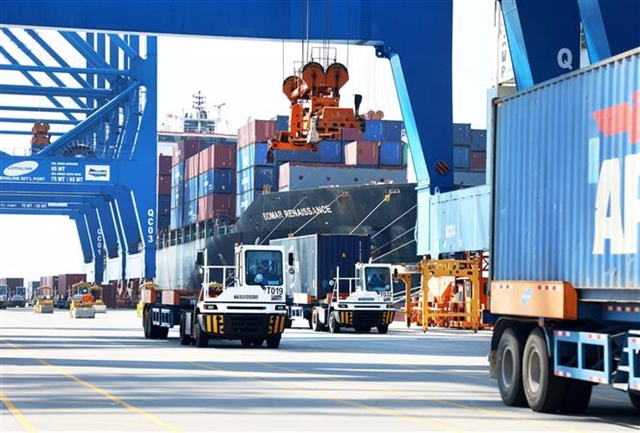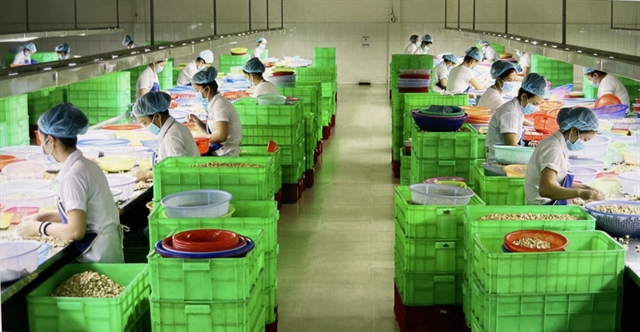 Economy
Economy

 |
| A cashew processing line for exports in the southern province of Bình Phước. VNA/VNS Hồng Nhung |
HÀ NỘI — The Asian Development Bank (ADB) has kept the growth outlook for Việt Nam in 2024 and 2025 unchanged at 6 per cent and 6.2 per cent respectively, on the back of a strong first-half performance in 2024.
The forecast was released on Wednesday in the latest edition of Asian Development Outlook (ADO), which periodically provides assessment of recent economic developments in Asia and the Pacific and medium-term macroeconomic projections for the region.
The report said that trade-related manufacturing - one of the main drivers of recovery - is expected to slow down over the near term, while domestic demand will also remain subdued. Inflation is projected to stabilise at 4 per cent.
Shantanu Chakraborty, ADB Country Director for Việt Nam said: “The first half of 2024 was quite impressive, with GDP growth at 6.4 per cent compared to the same period last year. This was mainly driven by strong trade recovery, where exports grew by 14.5 per cent and import by 17 per cent over last year. However, the domestic segment remained sluggish, with final consumption growing by only 5.8 per cent.
“Việt Nam can maintain its growth momentum in 2024 through sustained trade recovery in export-led manufacturing and positive inflows of FDI and remittances, while making more efforts for growth restoration in services, stable agriculture production and domestic consumption recovery.”
He said that though the economy is expected to post solid growth this year and grow at a slightly higher pace next year, the bank sees several external downside risks that could slow down Việt Nam’s momentum, including softened global demand caused by slow economic recovery among its trading partners and continued geopolitical tensions.
Both could slow down the recovery of Việt Nam’s export-led growth and lower pace of normalisation of interest rates in the US and other advanced economies, which would continue to put pressure on the exchange rate. Growth in 2024 also depends on effective implementation of the Government’s fiscal measures and public investment.
“In recent years, the relative slowdown in growth has exposed the risks of structural fragilities in the Việt Nam economy, for example the reliance on FDI-led export manufacturing, the incipient capital markets and overreliance on bank credit, among others. If these risks are addressed in a timely fashion, Việt Nam could achieve stronger growth. Policy measures in 2024 would therefore need to combine short-term growth support measures to strengthen domestic demand with long-term structural remedies to promote sustainable development,” he said.
ADB has also slightly raised its economic growth forecast for developing Asia and the Pacific this year to 5.0 per cent from a previous projection of 4.9 per cent, as rising regional exports complement resilient domestic demand. The growth outlook for next year is maintained at 4.9 per cent.
Inflation is forecast to slow to 2.9 per cent this year amid easing global food prices and the lingering effects of higher interest rates.
After a post-pandemic recovery that was driven mainly by domestic demand, exports are rebounding and helping propel the region’s economic growth. Strong global demand for electronics, particularly semiconductors used for high-technology and artificial intelligence applications, is boosting exports from several Asian economies.
“Most of Asia and the Pacific is seeing faster economic growth compared with the second half of last year,” said ADB Chief Economist Albert Park. “The region’s fundamentals remain strong, but policymakers still need to pay attention to a number of risks that could affect the outlook, from uncertainty related to election outcomes in major economies to interest rate decisions and geopolitical tensions.”
While inflation is moderating toward pre-pandemic levels in the region as a whole, price pressures remain elevated in some economies. Food inflation is still high in South Asia, Southeast Asia and the Pacific, in part due to adverse weather and food export restrictions in some economies.
The growth forecast for the People’s Republic of China (PRC), the region’s largest economy, is maintained at 4.8 per cent this year. A continued recovery in services consumption and stronger-than-expected exports and industrial activity are supporting the expansion, even as the PRC’s struggling property sector has yet to stabilise. The Government introduced additional policy measures in May to support the property market.
The outlook for India, the region’s fastest-growing economy, is also unchanged at 7 per cent for the fiscal year 2024. India’s industrial sector is projected to grow robustly, driven by manufacturing and strong demand in construction. Agriculture is expected to rebound amid forecasts for an above-normal monsoon, while investment demand remains strong, led by public investment.
For Southeast Asia, the growth forecast is maintained at 4.6 per cent this year amid solid improvements in both domestic and external demand.
This year’s outlook for the Caucasus and Central Asia is raised to 4.5 per cent, from a previous projection of 4.3 per cent, driven in part by stronger-than-expected growth in Azerbaijan and the Kyrgyz Republic.
In the Pacific, the outlook for 2024 is maintained at 3.3 per cent growth, driven by tourism and infrastructure spending, along with revived mining activity in Papua New Guinea. — VNS




